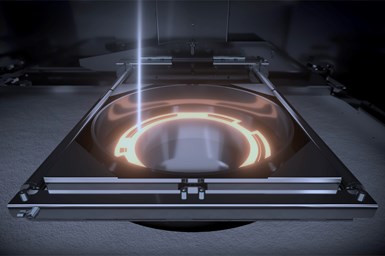Jeol’s Electron Beam 3D Printer Meets Aerospace Qualification Standard
The company says that meeting the AMS7032 operational qualification standard ensures manufacturers that Jeol’s JAM-5200EBM is capable of producing aerospace-grade material with stable performance and meets all material specification requirements.
Share
Read Next
Jeol's e-Shield powder dispersal prevention helps create a helium-free environment that enables parts to be manufactured in a clean space at a low-cost. Photo Credit: Jeol
Jeol’s JAM-5200EBM metal 3D printer, a production-ready electron beam powder bed fusion (EB-PBF) additive manufacturing (AM) solution, has demonstrated the ability to meet the AMS7032 operational qualification (OQ) standards, while achieving the AMS7011 material requirements for Ti-6Al-4V alloy with post-deposition hot isostatic pressing (HIP). Jeol says it is the first EB-PBF machine known to meet the requirements of AMS7011 since they were first established on another EB-PBF manufacturer’s model.
The AMS7032 Operational Qualification Standard evaluates the ability of an AM PBF machine to consistently meet material specification requirements while maintaining process control and stability over several builds. To comply with the OQ procedures listed in AMS7032, three identical builds containing a large number of Ti-6Al-4V specimens in all three orientations and encompassing the entire JAM-5200EBM build envelope were made using reused powder that conformed to the AMS7015 specification. The specimens were then subjected to tensile testing, microstructure evaluation, chemical composition testing, radiography and other tests to verify they met the requirements of AMS7011. All required postprocessing and testing of the specimen was performed at an ISO17025-accredited laboratory.
The results of the testing not only demonstrated the high stability of the machine but also revealed a key strength of this system — the Jeol JAM-5200EBM system produces material with excellent ductility and very low anisotropy. These results also indicate that designers should have significant freedom in how parts are oriented within the build envelope, thus enabling greater design for additive manufacturing (DfAM) flexibility and unlocking the potential for truly optimized designs.
“Jeol has provided metrology, analytical and electron beam manufacturing instruments for over 70 years, and understands that manufacturers must have confidence in their tools,” says Bob Pohorenec, president of Jeol USA. “Meeting the AMS7032 operational qualification standard ensures manufacturers that the JAM-5200EBM is capable of producing aerospace-grade material with stable performance and meets all material specification requirements. This achievement is a testament to our commitment to quality and reliability.”
For businesses operating in the aerospace industry, our efforts greenlight a new alternative for 3D metal printing of parts essential in the manufacturing process. This grants them access to Jeol’s more than 70 years of electron beam expertise and grants the peace of mind that parts will meet compliance standards set in place to avoid failures.
Jeol is excited to share the insights and outcomes of its success meeting the qualification standards of AMS7032 and the material requirements of AMS 7011 with the wider community. The results were first presented at the Fall meeting of the SAE AMS AM Additive Manufacturing Metals committee, and the NRC Workshop on Advanced Manufacturing Technologies for Nuclear Applications, both held in October. Jeol will further host a webinar on Dec. 5 at 2 p.m. ET, offering an in-depth discussion of the results, capabilities and future prospects of this AM system.
- Read about Jeol installing a metal 3D printer at Cumberland Additive. This will be the first installation of Jeol’s E-beam system in North America, giving it new opportunities to demonstrate the abilities of the system in a dedicated environment for additive manufacturing."
- Learn more about Jeol’s E-beam metal am 3D printer for improved productivity. This electron beam melting powder bed fusion machine is said to achieve high productivity, reproducibility and accuracy due to its automatic correction of focus and spot shape.
Related Content
Beehive Industries Is Going Big on Small-Scale Engines Made Through Additive Manufacturing
Backed by decades of experience in both aviation and additive, the company is now laser-focused on a single goal: developing, proving and scaling production of engines providing 5,000 lbs of thrust or less.
Read MoreAt General Atomics, Do Unmanned Aerial Systems Reveal the Future of Aircraft Manufacturing?
The maker of the Predator and SkyGuardian remote aircraft can implement additive manufacturing more rapidly and widely than the makers of other types of planes. The role of 3D printing in current and future UAS components hints at how far AM can go to save cost and time in aircraft production and design.
Read More3D Printed NASA Thrust Chamber Assembly Combines Two Metal Processes: The Cool Parts Show #71
Laser powder bed fusion and directed energy deposition combine for an integrated multimetal rocket propulsion system that will save cost and time for NASA. The Cool Parts Show visits NASA’s Marshall Space Flight Center.
Read MoreTwo 12-Laser AM Machines at Collins Aerospace: Here Is How They Are Being Used
With this additive manufacturing capacity, one room of the Collins Iowa facility performs the work previously requiring a supply chain. Production yield will nearly double, and lead times will be more than 80% shorter.
Read MoreRead Next
Profilometry-Based Indentation Plastometry (PIP) as an Alternative to Standard Tensile Testing
UK-based Plastometrex offers a benchtop testing device utilizing PIP to quickly and easily analyze the yield strength, tensile strength and uniform elongation of samples and even printed parts. The solution is particularly useful for additive manufacturing.
Read MoreBike Manufacturer Uses Additive Manufacturing to Create Lighter, More Complex, Customized Parts
Titanium bike frame manufacturer Hanglun Technology mixes precision casting with 3D printing to create bikes that offer increased speed and reduced turbulence during long-distance rides, offering a smoother, faster and more efficient cycling experience.
Read MoreCrushable Lattices: The Lightweight Structures That Will Protect an Interplanetary Payload
NASA uses laser powder bed fusion plus chemical etching to create the lattice forms engineered to keep Mars rocks safe during a crash landing on Earth.
Read More





















